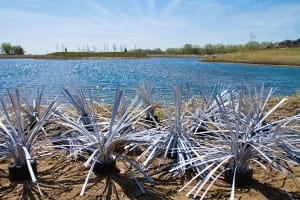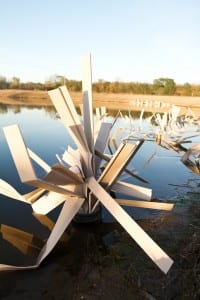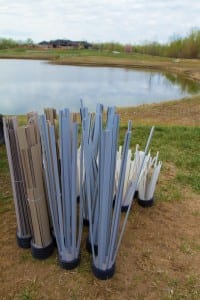| Researchers at Floating Island International (FII) in Shepherd, Mont., an agricultural region, are fishing nonpoint source nutrients out of 2.6-ha (6.5-ac) Fish Fry Lake. Bruce Kania, FII project development director, uses rod and reel to maintain floating treatment wetlands (FTWs) in the lake. Fishing is all part of the job; experienced anglers can catch one fish every 2 minutes at Fish Fry, he said. | |
 | The man-made floating islands transfer excess phosphorus from host water to periphyton, which is a colony composed of algae, bacteria, microbes, and organic matter. This colony serves as a food source for certain types of fish.In 2011, Fish Fry Lake removed 1.1 kg/ha (1 lb/ac) of phosphorus at a cost of $282/kg ($128/lb) and produced 112 kg/ha (100 lb/ac) of harvestable fish, Kania said. The lake’s clarity, measured by Secchi disk, improved to 5.8 m (19 ft) from an initial condition of 0.4 m (1.2 ft) with ongoing removal of suspended solids, according to FII. As of May, data indicate nutrient removal and catch rates are on their way to doubling in 2012, Kania said. |
| |
| FTWs offer effective, cost-efficient additional treatment to increase nutrient removal. Application is universal — they are operating in various climates. FII has 4400 FTWs installed in such places as New Zealand, where water quality managers grow eels to restock other waterways, and in Singapore, Indonesia, and across the United States, including Alaska. The islands hold fast, surviving typhoons, tornados, and active icy waters, Kania said.Data show that FTWs have vast potential to address water quality and promote aquaculture. “We’re trying to answer the question, ‘Can we engender a viable fishery … to ultimately improve water quality?’” Kania said. | |
| According to FII research, FTWs remove 93% of total suspended solids, 88% of phosphorus, 71% of total nitrogen, 88% of total organic carbon and chemical oxygen demand, 90% of copper, 95% of lead, and 36% of zinc. The data indicate that FTWs exceed removal rates of most comparable best management practices, such as retention ponds, wetland basins, media filters, and other manufactured devices.FTWs reduce algae, engender fish by growing periphyton and other biofilms, improve pond aesthetics, cool water, provide shade, and grow plants. FTWs can be used for effluent polishing, stormwater management applications, and lake restoration, Kania said. | |||
 |  | FTWs can help a community facing increased effluent standards. “FTWs can be installed into existing [wastewater] lagoons to improve the contaminant removal rates, thereby resulting in cleaner effluent,” said Frank Stewart of Stewart Engineering (Bozeman, Mont.), who is an engineering design consultant for FII. “In most cases, installing FTWs into existing lagoons is cheaper than building new lagoons, especially if land costs are considered,” he said. | |
 |
| ||
| FTWs also could reduce peak discharges for occasional out-of-compliance wastewater dischargers, as well as decrease the volume of nutrients generated by livestock lagoons, Stewart added.Half the Cost While the systems do not work well in urban areas because of site restrictions, cities can get credit for contaminants removed from smaller upstream communities. “The cleanup effect for the river is the same, but the removal is much cheaper,” Stewart said. According to Mark Reinsel of Apex Engineering (Missoula, Mont.), who establishes testing protocols and analyzes FII water data, FTWs cost less than 50% of traditional treatment, including alum. Floating islands cost between $269 and $484 per m2 ($25 and $45 per ft2), depending on whether aeration is incorporated. Plants, which increase longevity and stability, increase costs. See the dozens of unique artificial fish habitat models, fish attractors and fish cover used at fishiding.com, the leader in proven science based, fish protection. Biofilm and periphyton love dirty water — the more of it in contact with the matrix, “the faster the biofilms remove contaminants,” Stewart said. Adding aeration increases DO concentrations due to mixing, lowers overall water temperatures, and hastens periphyton growth, researchers explained. With increased sunlight and circulation, FTWs increase in size and density. As periphyton takes in phosphorus and transfers it to the fish that feed on it, DO levels rise and turbidity decreases. Sunlight reaches into lower levels of the water column, enhancing diatom?based periphyton growth. As FTWs grow, they become more diversified and stable, enabling them to remove more phosphorus and generate larger fish populations. One aerated 230-m2 (2500-ft2) model in Fish Fry Lake circulates up to 2 m3 (72 ft3) of air per minute and 40 m3 (10,400 gal) of direct flow with a 2.25-kW (3-hp) motor. FTWs with aeration destratify the 8.5-m-deep (28-ft-deep) lake and homogenize temperatures when needed, Kania said. | |
Efficiency and Design Life According to Reinsel, FTWs “are more effective than treatment methods that are relying on settling.”Reinsel measures effectiveness in pounds of phosphorus per year per cubic foot of FTW. Rain gardens and stormwater retention basins are 20% to 30% effective, while the floating islands are 60% to 70% effective, he said. Data on design life are sparse — FII’s oldest floating island is 8 years old. After 20 to 30 years, an FTW may have to be harvested. The Art of FTW Maintenance |  |
| |
| Other than all that fishing and frying, Stewart said FTWs are easy to manage.“Relative to eutrophied waters, catch-and-harvest needs to be the new mantra,” Kania said. | |






